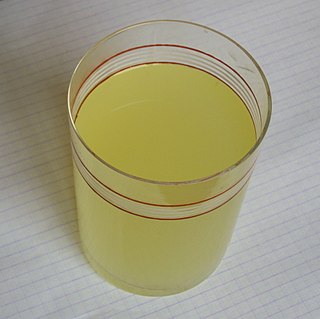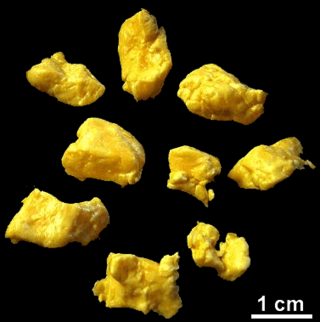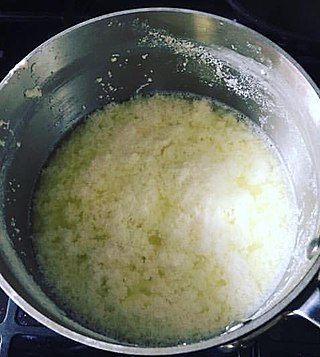Related Research Articles

Rennet is a complex set of enzymes produced in the stomachs of ruminant mammals. Chymosin, its key component, is a protease enzyme that curdles the casein in milk. In addition to chymosin, rennet contains other enzymes, such as pepsin and a lipase.

Trypsin is an enzyme in the first section of the small intestine that starts the digestion of protein molecules by cutting long chains of amino acids into smaller pieces. It is a serine protease from the PA clan superfamily, found in the digestive system of many vertebrates, where it hydrolyzes proteins. Trypsin is formed in the small intestine when its proenzyme form, the trypsinogen produced by the pancreas, is activated. Trypsin cuts peptide chains mainly at the carboxyl side of the amino acids lysine or arginine. It is used for numerous biotechnological processes. The process is commonly referred to as trypsin proteolysis or trypsinization, and proteins that have been digested/treated with trypsin are said to have been trypsinized. Trypsin was discovered in 1876 by Wilhelm Kühne and was named from the Ancient Greek word for rubbing since it was first isolated by rubbing the pancreas with glycerin.

A protease is an enzyme that catalyzes proteolysis, breaking down proteins into smaller polypeptides or single amino acids, and spurring the formation of new protein products. They do this by cleaving the peptide bonds within proteins by hydrolysis, a reaction where water breaks bonds. Proteases are involved in many biological functions, including digestion of ingested proteins, protein catabolism, and cell signaling.

Chymosin or rennin is a protease found in rennet. It is an aspartic endopeptidase belonging to MEROPS A1 family. It is produced by newborn ruminant animals in the lining of the abomasum to curdle the milk they ingest, allowing a longer residence in the bowels and better absorption. It is widely used in the production of cheese.

Casein is a family of related phosphoproteins that are commonly found in mammalian milk, comprising about 80% of the proteins in cow's milk and between 20% and 60% of the proteins in human milk. Sheep and Cow milk have a higher casein content than other types of milk with human milk having a particularly low casein content.

Whey is the liquid remaining after milk has been curdled and strained. It is a byproduct of the manufacturing of cheese or casein and has several commercial uses. Sweet whey is a byproduct resulting from the manufacture of rennet types of hard cheese, like cheddar or Swiss cheese. Acid whey is a byproduct brought out during the making of acid types of dairy products, such as strained yogurt.

Curd is obtained by coagulating milk in a sequential process called curdling. It can be a final dairy product or the first stage in cheesemaking. The coagulation can be caused by adding rennet, a culture, or any edible acidic substance such as lemon juice or vinegar, and then allowing it to coagulate. The increased acidity causes the milk proteins (casein) to tangle into solid masses, or curds. Milk that has been left to sour will also naturally produce curds, and sour milk cheeses are produced this way. Producing cheese curds is one of the first steps in cheesemaking; the curds are pressed and drained to varying amounts for different styles of cheese and different secondary agents are introduced before the desired aging finishes the cheese. The remaining liquid, which contains only whey proteins, is the whey. In cow's milk, 90 percent of the proteins are caseins. Curds can be used in baking or may be consumed as a snack.

Cheesemaking is the craft of making cheese. The production of cheese, like many other food preservation processes, allows the nutritional and economic value of a food material, in this case milk, to be preserved in concentrated form. Cheesemaking allows the production of the cheese with diverse flavors and consistencies.

Blue cheese is semi-soft cheese with a sharp, salty flavor. It is made with cultures of the edible mold Penicillium, giving it spots or veins throughout the cheese in shades of blue or green. It carries a distinct smell, either from the mold or from various specially cultivated bacteria such as Brevibacterium linens.

Curdling is the breaking of an emulsion or colloid into large parts of different composition through the physio-chemical processes of flocculation, creaming, and coalescence. Curdling is purposeful in the production of cheese curd and tofu; undesirable in the production of a sauce, cheese fondue or a custard.

Acid-set or sour milk cheese is cheese that has been curdled (coagulated) by natural souring, often from lactic acid bacteria, or by the addition of acid. This type of cheese is technologically simple to produce.

Whey protein is a mixture of proteins isolated from whey, the liquid material created as a by-product of cheese production. The proteins consist of α-lactalbumin, β-lactoglobulin, serum albumin and immunoglobulins. Glycomacropeptide also makes up the third largest component but is not a protein. Whey protein is commonly marketed as a protein supplement, and various health claims have been attributed to it. A review published in 2010 in the European Food Safety Authority Journal concluded that the provided literature did not adequately support the proposed claims. For muscle growth, whey protein has been shown to be slightly better compared to other types of protein, such as casein or soy.

Easy Cheese is the trademark for a processed cheese spread product distributed by Mondelēz International. It is also commonly referred to by generic terms such as "spray cheese", "squirt cheese" or "cheese in a can". Easy Cheese is packaged in a metal can filled with air covered with a plastic cap that reveals a straight, flexible nozzle where the cheese is extruded.
Protein metabolism denotes the various biochemical processes responsible for the synthesis of proteins and amino acids (anabolism), and the breakdown of proteins by catabolism.

Tvorog is a white cheese. This is a non-liquid white fermented milk product, traditional for Eastern, Northern and Central Europe, obtained by fermenting milk with subsequent serum removal. It is officially customary to classify Tvorog produced in the traditional way, according to its fat content. According to GOST RF, according to physical and chemical indicators, Tvorog is divided into the following categories: fat-free, low-fat, classic and fatty. Also, according to the method of manufacture, such types of Tvorog are distinguished as simple, soft, and grained Tvorog, which is a type of low-fat Tvorog.

Pasta filata is a technique in the manufacture of a family of Italian cheeses also known in English as stretched-curd, pulled-curd, and plastic-curd cheeses. Stretched curd cheeses manufactured using the pasta filata technique undergo a plasticising and kneading treatment of the fresh curd in hot water, which gives the cheese its fibrous structure.

Cheese is a dairy product produced in wide ranges of flavors, textures, and forms by coagulation of the milk protein casein. It comprises proteins and fat from milk. During production, milk is usually acidified and either the enzymes of rennet or bacterial enzymes with similar activity are added to cause the casein to coagulate. The solid curds are then separated from the liquid whey and pressed into finished cheese. Some cheeses have aromatic molds on the rind, the outer layer, or throughout.
Κ-casein, or kappa casein, is a mammalian milk protein involved in several important physiological processes. Chymosin splits K-casein into an insoluble peptide and water-soluble glycomacropeptide (GMP). GMP is responsible for an increased efficiency of digestion, prevention of neonate hypersensitivity to ingested proteins, and inhibition of gastric pathogens. The human gene for κ-casein is CSN3.

Zingibain, zingipain, or ginger protease is a cysteine protease enzyme found in ginger rhizomes. It catalyses the preferential cleavage of peptides with a proline residue at the P2 position. It has two distinct forms, ginger protease I (GP-I) and ginger protease II (GP-II).

Sour cream or soured cream is a dairy product obtained by fermenting regular cream with certain kinds of lactic acid bacteria. The bacterial culture, which is introduced either deliberately or naturally, sours and thickens the cream. Its name comes from the production of lactic acid by bacterial fermentation, which is called souring. Crème fraîche is one type of sour cream with a high fat content and less sour taste.
References
- ↑ Neelima; Sharma, Rajan; Rajput, Yudhishthir Singh; Mann, Bimlesh (2013). "Chemical and functional properties of glycomacropeptide (GMP) and its role in the detection of cheese whey adulteration in milk: a review". Dairy Science & Technology. 93 (1): 21–43. doi:10.1007/s13594-012-0095-0. ISSN 1958-5586. PMC 3567326 . PMID 23396893.
- ↑ Córdova, Dávalos (March 11, 2019). "Glycomacropeptide Bioactivity and Health: A Review Highlighting Action Mechanisms and Signaling Pathways". Nutrients. 11 (3): 598. doi: 10.3390/nu11030598 . PMC 6471465 . PMID 30870995.